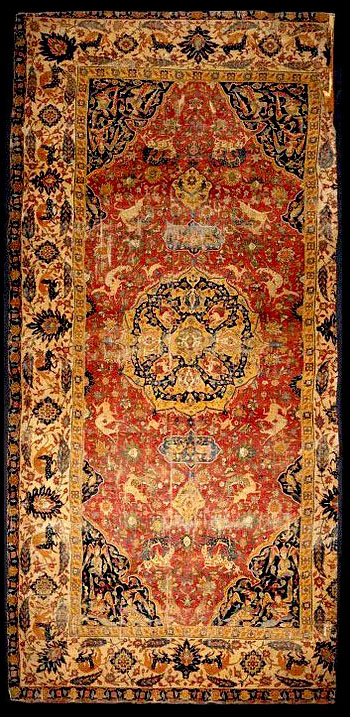|
Place of origin: Iran (made)
Date: 1500-1599 (made)
Artist/Maker: Unknown (production)
Materials and Techniques: Hand knotted woollen pile, on cotton warp
and
cotton and silk weft; asymmetrical knot, open to the left; 225 knots per sq.
in
(3,660 per sq. dm)
Museum number: 23-1883
Gallery location: In Storage
Public access description
The central medallion of this large carpet has a yellow ground and broad
blue interlaced stems containing small flowerheads. The interlacing
encloses animals and flowers and there is a pair of birds in the centre.
There are quarter medallions in the corners of the field which have a
dark blue ground and contain three angels, two of which hold animals or
birds. The red field is decorated with animals in combat; these include
chilins, tigers, wolves, cheetahs and gazelles. There are also human faces
within the larger blossoms.
Physical description
Carpet, Hunting Carpet, Sanguszko Carpet, hand knotted woollen pile on
cotton warp and cotton and silk weft, Persian, 16th century.
Warp: white cotton, Z4S, 30 threads per inch/ 122 per dm; depressed
Weft: white cotton and white silk; unable to ascertain spin, ply and twist,
3 shoots after each row of knots [probably two of cotton and one of
silk]; 15 knots per inch/60 per dm.
Pile: wool; 13 colours: red, orange, yellow, light yellow, dark green,
green, dark blue, blue, light blue, brown, light brown, pink, white;
asymmetrical knot open to the left and tied around two warp threads; 225
knots per sq.inch/3660 per sq.dm
Side Finish: Missing
End Finish: Missing
Design: Field: red ground with a central medallion which has a yellow
ground and which has broad blue interlaced stems containing small
flowerheads. The interlacing encloses animals and flowers and there is a
apir of birds in the centre. Above and below this medallion there is a
blue ground cartouche and a yellow ground pendant. There are quarter
medallions in the corners of the field: these have a dark blue ground
and contain three angels, two of which hold animals or birds.The red field
is decorated with animals in combat; these include chilins, tigers,
wolves, cheetahs and gazelles. There are also human faces within the larger
blossoms. The ground is decorated with delicate green curving
stems and blossoms.
Main border, part of which is missing along the left hand side: white ground
with large dark blue palmettes, animals in combat, blue/yellow
rosettes and long serrated blue leaves.
Inner border: yellow ground with an orange meander with blue/white/red
flowers and brown/white rosettes.
Outer border, missing along the left hand side: dark blue ground with
adouble meander in red outlined with yellow. There are large orange or
yellow animals heads alternating with a small blue head in profile.
Museum number
23-1883
Object history note
Purchased from A. Myers & Son.
URL
http://collections.vam.ac.uk/item/O67221/carpet-unknown/
|
 |

